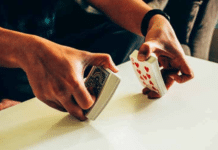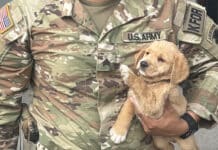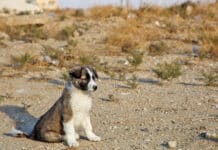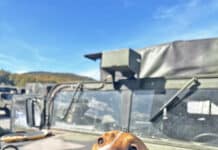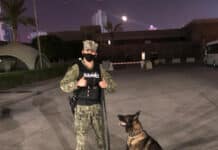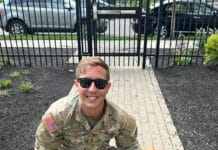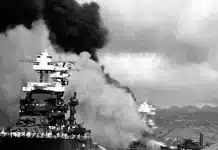
By Dave LeMieux
This month 75 years ago …
Veterans of Finland’s 1918 war of independence watched from Muskegon as their former countrymen fought against both sides in WWII.
In December 1939, The Chronicle said,
MUSKEGON VETERANS OF FINLAND’S 1918 WAR
There is an old saying in Finland that it “takes 10 Russians to kill one Finn.”
Iver Herrgord, 1825 Franklin St., recalled the saying today as he predicted that the Finnish Army might hold out indefinitely against the vastly superior forces of Soviet Russia if supplied with food and war material by other nations. He is one of the veterans of the Finnish war for independence now living here.
Another is John Majors. Herrgord and Majors were born and reared as neighbors on farms about 16 miles from Vaasa, Finland, and took part in the same battles during the war in which Baron Carl Gustaf von Mannerheim, present commander of the Finn Army, drove out of his country combined forces consisting of Soviet militia, Soviet sympathizers and troops of the Czar which had been garrisoned in Finland and were looking for pillage.
Praise modern fighters
Compared with the existing war in Finland, the Muskegon veterans of the war for independence modestly described their struggle as a minor affair and paid high tribute to the modern Finnish Army which in the past two months has given the world a new epic of bravery in the face of great odds.
Yet, according to Mr. Herrgord, the Finnish war for independence was bitterly fought and cost thousands of lives during the five months during which the struggle raged and in wholesale executions later.
Until 1917, Finland was a grand duchy of the Czarist Empire, but the people enjoyed a large measure of autonomy including their own parliament. When the Czarist government collapsed, the Finns organized a military force similar to the national guard here and the three Muskegon veterans of the Finnish war joined the national army.
Opposing the nationalist movement, the Communists, their Finnish adherents and the former Czarist garrisons scourged the country, looting the homes of the well-to-do and robbing farmers. Events reached a crisis in January 1918 when the Muskegon veterans answered the call of Baron Mannerheim for a war against the Communists.
They fought at Vaasa
First action in which the Muskegon veterans took part was at Vaasa, a large town on the Gulf of Bothnia. Herrgord and Majors were in the Finnish force which captured the Vasklot Island, opposite Vaasa, then came ashore and captured the Russian garrison of more than 1,500 soldiers.
Mannerheim ordered the Russians deported with a warning of death should they return.
Farmers formed the backbone of the Finnish forces which rallied to the call of Baron Mannerheim in January 1918. They rounded up Communists in eastern Finland, then marched south to meet a concentration of Red troops at Tammerfors. Mannerheim’s victory there was the turning point for the Finns.
The battle lasted several days and in one of the actions Herrgord was with a cavalry force which cut off the retreat of a Communist battalion while Major was with an infantry battalion which was making a frontal attack the same enemy. The Russians were annihilated.
Lay flat in the snow
“We saw machine guns mow them down and hundreds of bodies lay in the snow when the battled ended,” Herrgord declared. “While we were encircling the Communists, the cavalry force was under fire from the Finns and Russians. My horse and I lay flat in the snow until it was time for us to attack.”
The Muskegon men saw action at a small town called Filppula near Tammerfors. There Herrgord was riding patrol alone and a shell landed so close it bowed his horse’s legs but both survived unscathed. Another time, he and three companions took shelter in a bakery.
He hid safely in the fireplace but his companions were killed. His closest escape was, he said, when a bullet passed through his tunic, but did not touch him.
During the battle around Tammerfors, Majors was stationed in a woods near a road. A Russian shell landed nearby and either a shell fragment or a piece of frozen dirt carried off his soldier’s cap, but spared him.
His most memorable sight was a night engagement near Tammerfors in which the Russians, using explosive bullets, peppered the woods held by the Finns and he said the display was like the Fourth of July and “sounded like a coffee grinder.”
Aided by Germany
German forces, dispatched by the Kaiser, paved the way for Finnish independence. A German general, Count Rudiger von der Goltz, stopped a drive by the Red forces at Karis, on April 6, 1918 whereupon Mannerheim attacked and dispersed the Reds at Tammerfors a few days later, leading to Mannerheim’s triumph in early May at Vilpuri, one of the cities recently under Soviet artillery fire.
Mannerheim then captured Helsinki and the war ended, leading eventually to the Finn-Soviet treaty of 1920, denounced by Stalin late this year.
In the 1918 war, Herrgord recalled that the women Reds fought side by side with the Russian men and in one battle held the lines while the men retreated. They were, he said, Finnish women for the most part.
All three Muskegon veterans of the Finnish war came to Michigan in the post war period at the invitation of relatives. All are married and work in factories here. Majors was married in Finland during a visit in 1925. Mr. and Mrs. Herrgord spent the summer of 1937 in Finland and Sweden.
Muskegon’s Finnish veterans
The countrymen John Majors and Iver Herrgold left behind after the war for independence in 1918 would have to fight on both sides in World War II to finally secure Finland’s independence.
Battling alone against the Soviets from 1939 to 1940, the Finns aligned with Nazi Germany when Hitler invaded Russia in 1941, an alliance that lasted until the Finns signed an armistice with the Allies in 1944.
By the time the war ended, the Finns had secured their independence at the cost of the country’s second largest city, Vilpuri, and a tenth of their land.
Majors proved to be one of Muskegon’s cleverest inventors, securing a U.S. patent for a lockbox to keep his light-fingered neighbors from stealing his milk after the milkman delivered it to his home.
As described by The Chronicle, “The receptacle is the type built into the wall of a house for delivery of food and packages. After the exterior door has been opened for a delivery, the door locks. When the interior door is opened and closed, the exterior lock automatically is reset for the next delivery.”
John Majors died in 1963.
All content herein is owned by author exclusively. Expressed opinions are NOT necessarily the views of VNR, authors, affiliates, advertisers, sponsors, partners, technicians, or VT Network. Some content may be satirical in nature.
All images within are full responsibility of the author and NOT VNR.
Read Full Policy Notice - Comment Policy











